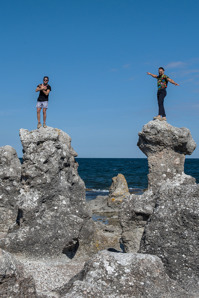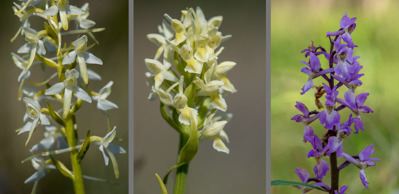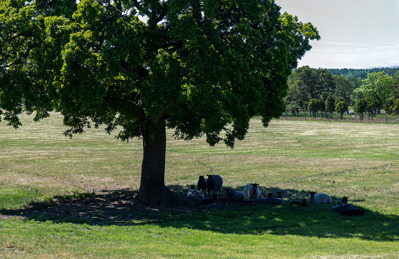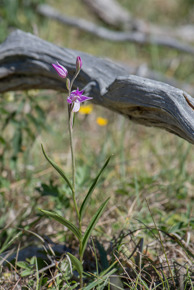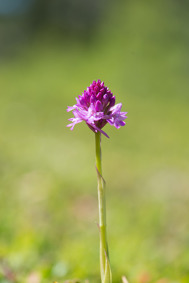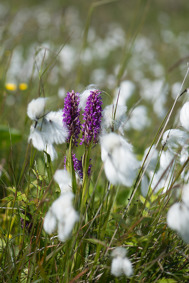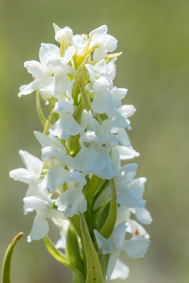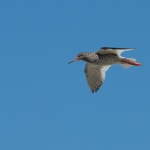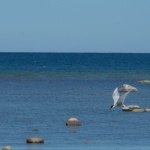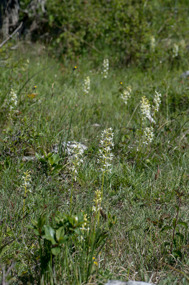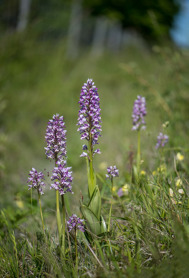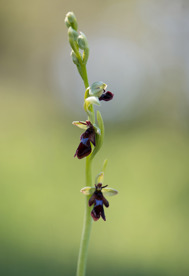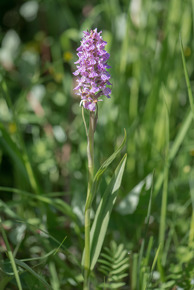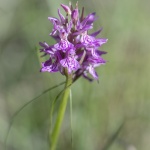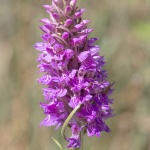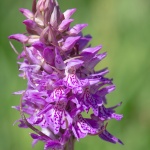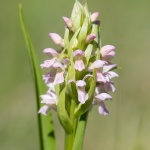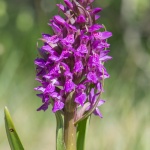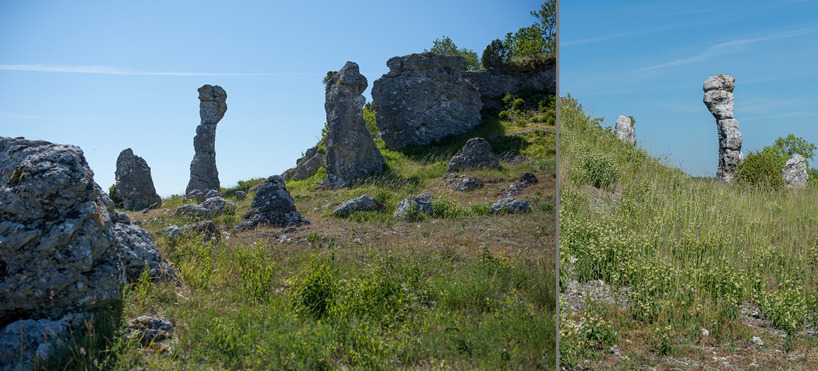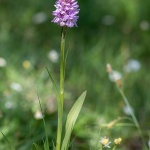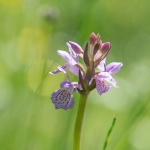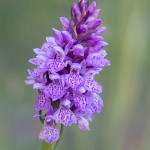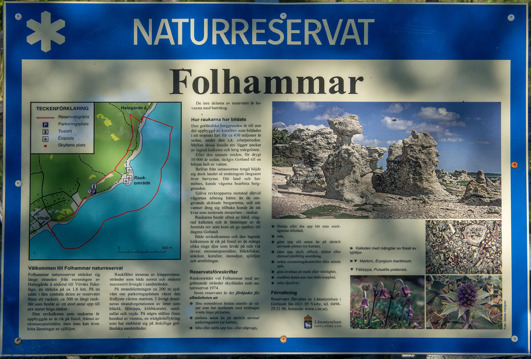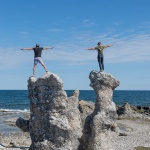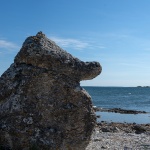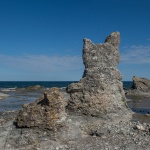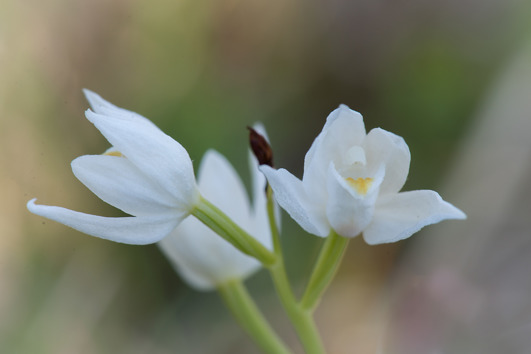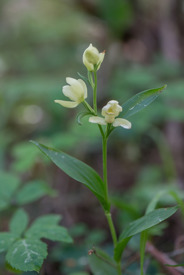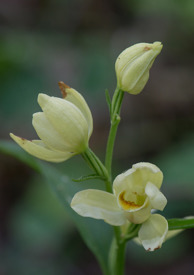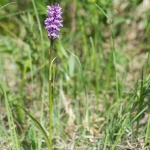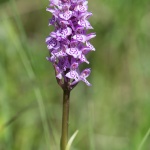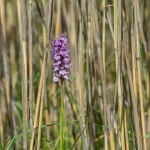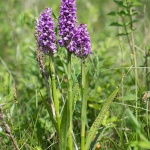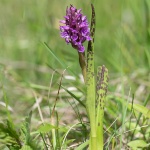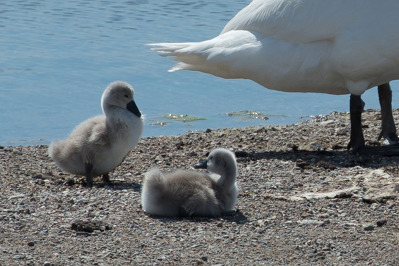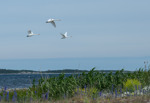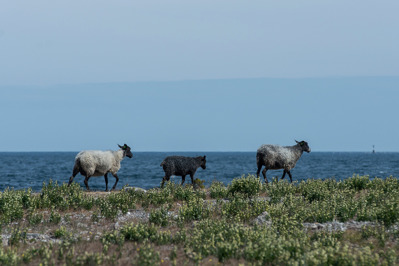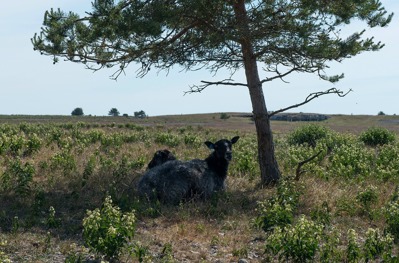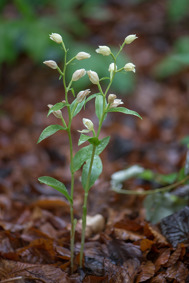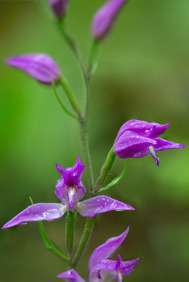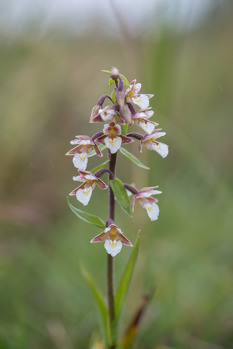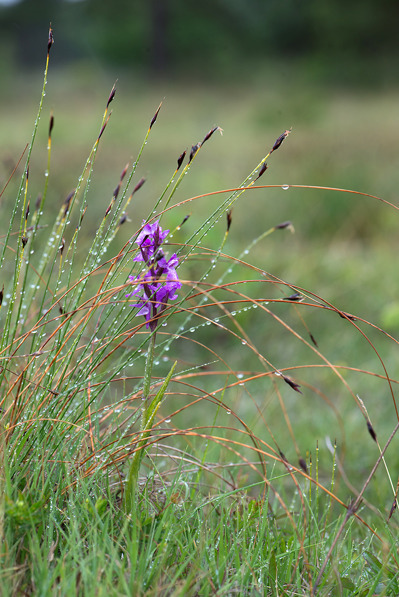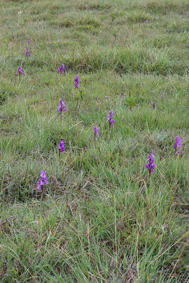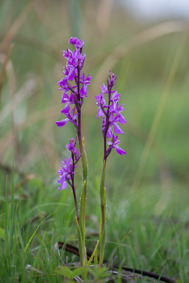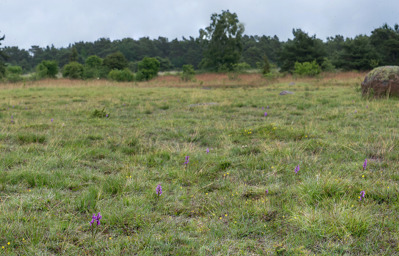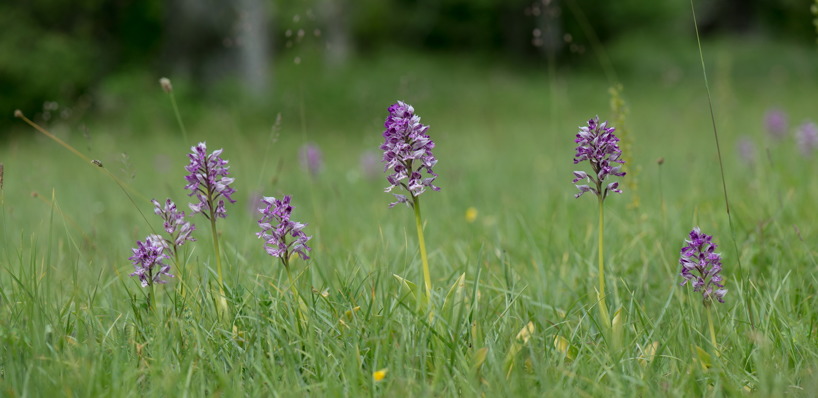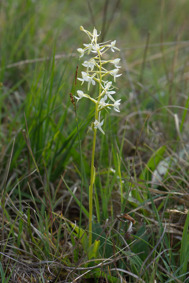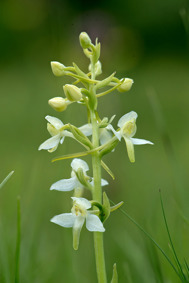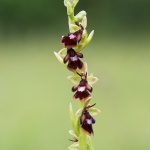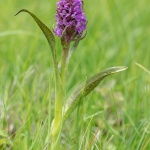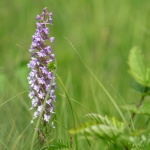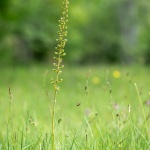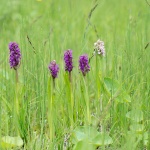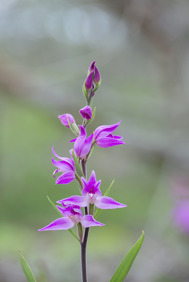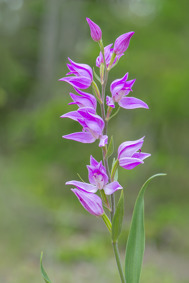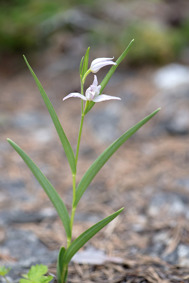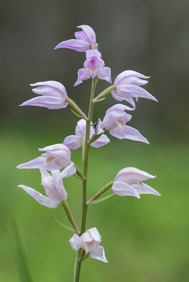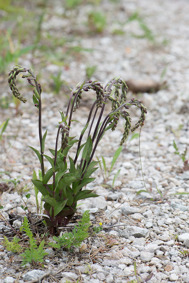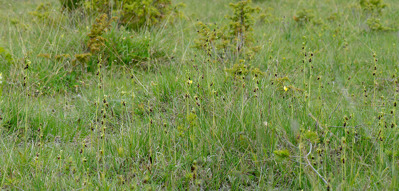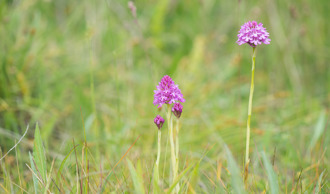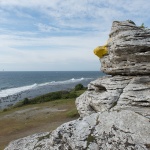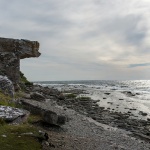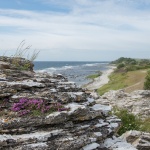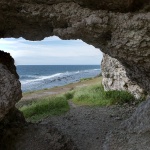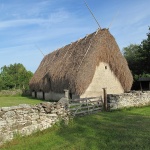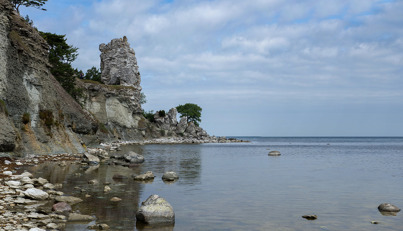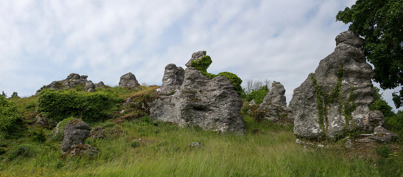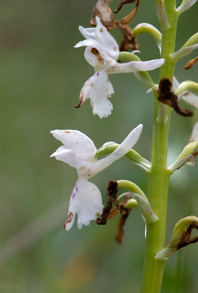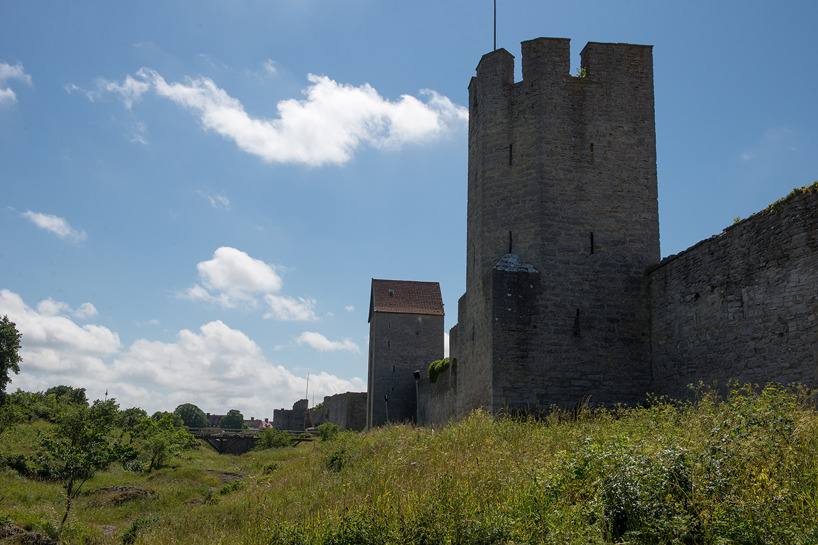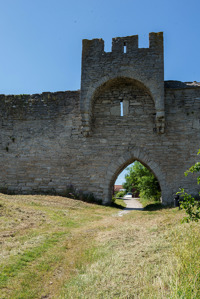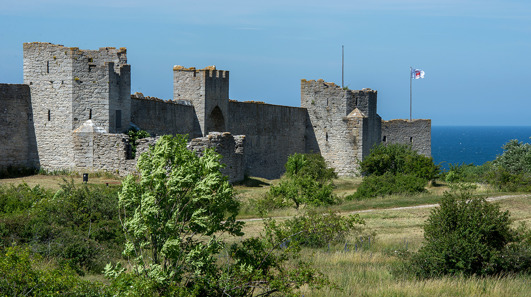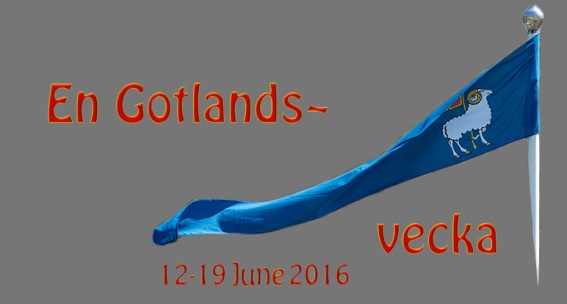
No direct site koordinates are given in the text below. For info about such please contact me using the "Kontakt" form.
All pictures will open in a larger format by clicking in the picture.
Finally our journey to Gotland came thru! After that we for several years have been thinking about going back to Gotland, this year 2016, it happened. Our former visit was in early eighties and at that time there was no much time for orchid hunting. Anyhow I still remember those huge numbers of Elder-flowered Marsh Orchid (Dactylorhiza sambucina) we saw at our visit to Stora Karlsö, (a small island just west of Gotland).For many years my wife and I have prioritized other areas for our yearly spring journeys. Mostly it has been to southern Europe but this year we choose to stay one week at this easterly outpost of Sweden.
Outward journey started from Oskarshamn, 3 hours in nice summer weather at the ferry. Once in Visby we found our way to the booked cottage just outside Stenkyrka at the northern part of Gotland. This became our base for our excursions during the week.
Our week started with hot summer weather but ended in pouring rain. According to the locals, however, the rain was very welcome. Most of the spring had been very dry which we also could see in the field. Most of the areas, that at this time should have been wetlands, were completely dried up. This had also caused an early flowering among the orchids. That Dactylorhiza sambucina, Orchis spitzelii and Orchis mascula would be over was expected (although here and there in shady spots there were fine specimens of O. mascula), but that even Cephalanthera longifolia was over was a surprise. The same was true for D. damasonium that you had to look hard for to find in good condition. Another surprise was that Anacamptis palustris, which normally is flowering from the end of June and during July, now was at its best.
Monday, June 13
Our first excursion went north toward areas where Orchis spitzelii usually grow. The hope was to be able to find some late flowering specimen in a shady spot. But it turned out pretty quickly that this remained a wish. However, some nice Orchis mascula could still be found in such places.
Above are three of the species we saw at our first stop. From left Lesser Butterfly Orchid (Platanthera bifolia subsp. bifolia), Early Marsh Orchids (Dactylorhiza incarnata subsp. ochro-leuca) and finally a Early Purple Orchid (Orchis mascula).
Beautiful summer weather characterizes our first day and we understand the sheep who sought shade under the tree from the midday sun .
Hall
Our first attempt to find Spitzel’s Orchid (Orchis spitzelii) was done at Hall. Here, after one kilometer walk, you reach some fine seashore meadows. Already here it was clear that the dry climate, which had prevailed during spring, had caused all of the most sought-after orchids to wilt. There was lot of withered orchids there but not possible to determine which species. In the pinewood behind the meadow there was plenty of Bird’s Nest Orchid (Neottia nidus-avis) and even some Red Helleborine (Cephalanthera rubra) that just started to bloom.
Harudden
A new attempt to find a late-blooming Spitzel’s Orchids was made at Harudden but with the same disappointing results. There were however plenty of Early Marsh Orchids in the meadows, including a couple of pure-white variants of this. Even the marshes, that are just inside the coastline, had a lot of Early Marsh Orchids. Here at Harudden we found our first Pyramidal Orchid (Anacamptis pyramidalis) at this time just in the beginning of its flowering.
Above are some orchids found at Harudden. From left a Pyramidal Orchid (Anacamptis pyramidalis) that just started flowering. The other three images show different color variants of Early Marsh Orchids. The last one is a var. leucantha, not to be confused with subsp. ochroleuca.
Down here, at the beach, it's not just flowers that catch attention. A Redshank followed us all the way with its stubborn clipping sound. Artic Tern does not sound much but impresses with its ability to fly searching for food in the shallow waters near the shore line.
After a short visit at Halshuk fishing village, we started our way back home. But after only a few kilometers, we observed a field to the right with lots of Lesser Butterfly Orchid and had to do a new stop. Here was not only hundreds of Lesser Butterfly Orchid, but also plenty of Fragrant Orchids (Gymnadenia conopsea var. conopsea), Military orchids (Orchis militaris), Fly Orchid (Ophrys insectifera) and Twayblade (Neottia ovata).
Gylviken
Our second excursion took us eastward to the coast south of Slite. Here there are several sites for the so-called “Gylviksnycklarna” that is now considered as a subspecies of Western Marsh Orchid (Dactylorhiza majalis) and named as Dactylorhiza majalis subsp. elatior.
Just south of Sju Strömmar there is a site where you can find subsp. elatior re-crossed with Early Marsh Orchids or Common Spotted Orchid. These sometimes get mottled leaves, unlike the usual that have unstained, pure green leaves. Early Marsh Orchids was seen a lot of but no Common Spotted. Possibly these were slightly later and therefore not seen in all other green vegetation.
Viklau
Further south and more inland at Gotland lies Viklau. From here “Viklaunyklarna” are reported. After some searching and a walk through a cow pasture with frisky young cattle the orchids was finally found. Even these are defined to belong to the same subspecies of Western Marsh Orchids as “Gylviksnycklarna”, namely subsp. elatior. Some differences can be seen both in the plant environment and appearance. While “Gylviksnycklarna” grows in natural environments, in the edges of marshes, you will find “Viklaunycklarna”in culture affected areas and more nutrient-rich environments. Also the lip patterns of the flowers differ. Flowers from Gylviken has a lip patterns consisting of lines and arcs, while the pattern of those from Viklau are mostly composed of dots.
From Viklau we set course towards the east coast again. This time to Östergarn. At Östergarns Prästänge (Priests Mea-dow) we took our lunch before a closer look was taken at this typical Gotlandic meadow. Here I was told that Frog Orchid (Dactylorhiza viridis) would be but was not able to find some. However, there was a lot of Early Purple Orchid in nice condition.
Our tour then went towards Ljugarn, Vitvar and Folhammar sea-stack before we began the return trip to our cabin.
Roadside great colors
Wednesday June 15
Today's tour went down to Kinnarstugan and further towards Lummelunda in an attempt to find Large White Helleborine (Cephalanthera damasonium). We ended the excursion with a trip to Nybroviken in an effort to find Dactylorhiza majalis subsp. baltica. But first made a visit to Landträskdammen (a small dammed lake). Several orchids was found as Twayblade, Lesser Butterfly Orchid, Fly Orchid and Sword-leaved Helleborine (Cephalanthera longifolia) but not the Large White, even that it was noted from this site.
We continued our search for the Large White Helleborine and drove down to Kinnarstugan. Here, halfway down, we had better luck. In the woods to the right there were a few plants. But already here we could see that the hot and dry spring had made this species to flower early, which came to be even clearer later in the week.
We ended this day's excursion with a turn out to Nybroviken (Nybro Bay) and Åsunden, a small island in the bay. Nybroviken has a site from where Dactylorhiza majalis subsp. baltica is reported. This is an easterly species which, on the Swedish mainland, only are reported from the Piteå area in Northern Sweden. At Gotland there are a few sites. Besides subsp. baltica we also found Flecked Marsh Orchid (Dactylorhiza incarnata subsp. cruenta), Early Marsh Orchids, and something that was a possible cross between subsp. incarnata and subsp. baltica.
Asunden is a sheep grazed island at the entrance to Nybro-viken. A narrow isthmus almost connects it to the "mainland", there is only a narrow opening far out at the island. There is a road along the isthmus with a bridge over to the island where it is possible to park. The car ride over to the island provides good opportunities to study the bird life in the shallow waters along the isthmus.
The images here and the following slideshow show some of what we saw, Goosander, Mute swans, Herons and Common shelduck.
Downy chicks guarded by the mother
Thursday June 16
So far everything had shown that the vegetation was ahead of its normal time. We therefore decided that it perhaps was time to check if this also applied to the Lax-flowered Orchid (Anacamptis palustris). The weather had now changed and the day started with rain but forecasts said that southern Gotland would be better. So we started our journey to the rich fens where this orchid should grow. However, we first made a stop at Klinte church to again look for Large White Helleborine in the slopes and up towards Klinteberget, a hill behind the church. It turned out that there were hundreds of them but also that most of them almost were entirely withered. A number of the Red Helleborine was also growing in this slope. Those seemed to be at their best.
Our first attempt to find Lax-flowered Orchid (Anacamptis palustris) were at Esketräsk in Mästarmyr, former a large bog but now drained. It is said that this is the site where Lax-flowered Orchid first came into flower. And so they did now too. But it turned out when we visited Krakvät, which houses perhaps the largest population of this orchid on Gotland, that all plants there also were in full bloom.In Esketräsk there were a few flowering specimens while on the site at Krakvät there were probably several hundred.
“Krakvät” together with “Sävvät “and “Hägsarve kärräng” are nature reserves all having Lax-flowered Orchid as its largest jewel although there are a number of other orchids too. At Krakvät we found eg a fully flowering Marsh Helleborine (Epipactis palustris), which, anyway for me, was a record in early blooming.
Environment from Krakvät. Here the vegetation was sig-nificantly lower except in the wettest parts with saw-sedge. Although there was not much "fen" at the time for our visit, the area seemed wetter than at Esketräsk
Military Orchids was one of ne of characteristics plants Hässleänget (Hässle meadow)
Hessleänget
Friday came with really great weather again. We chose to once again take a turn to the north, this time up to Bläse and the area towards the old limestone quarry. We passed therefore Hässleänget (Hässle meadow) and made a stop there. This was a very nice area with many species, actually one of the species richest areas we visited. For example here we found the first Common Spotted Orchid (Dactylorhiza fuchsii subsp.fuchsii) at our trip, Plantanthera bifolia subsp. latifolia and something that was a suspected hybrid between this and Greater Butterfly Orchid (Platanthera clorantha), who also was found here.
The slideshow below shows further species found at Hässleänget.
Bläse
Now the area at the old lime mortar at Bläse was next target for today's excursion. Perhaps also Grindhammarsmyr east of the quarry. The hope of finding hybrid between Sword-leaved and Red Helleborine proved to be thru without walking down into the mire. In the sparse pine forest just before coming up to the barrier at the quarry were lots of Red Helleborine and also some 10 or so of the hybrid. There were also plentiful of Sword-leaved Helleborine but all were faded now. The Red Helleborine was at its best. The hybrid, which is light pink, seemed also to be something in the middle of the parents, not quite faded but not as fresh as the red one.
On our way back we drove the road 691 along Kappelhamnsviken. Just some km from the sign for the Industrial Museum in Bläsinge we stopped for coffee break at a picnic table on the stone embankment just inside the waterfront. The small area between the road and the beach, maybe 50 x 50 m, was one of the most species-rich areas we visited during our Gotland trip. In total there were about 10 species and perhaps the densest population of fly orchid I ever seen.
"Mother father and children". A group of Pyramidal Orchids from this our last site for the day.
View from Husrygg nature reserve
Saturday began with pouring rain. But the forecasts said that it would hold up in the southern part of the island after lunch. So after lunch we chose to do a tour around the narrow southern tip of Gotland and “Hoburgsgubben” (the sea stack “Hoburgs old man”), usually supposed to be a must for those who visit the island. If you visit this southern part of Gotland we recommend you to travel the narrow road from Kättleviken to Hoburgen. Idyllic and beautiful landscape where the road runs through the narrow area between the shore and the steep embankments (coastal cliffs covered with weathering gravel) inside. The road runs through Husrygg and Vaktbackars nature reserves.
A brief stop was made at Muskmyr on our way back home, an area that appeared to be very orchid rich.
Sunday June 19
Our Gotland week is nearing its end. Today we will go home again. But since the departure was not until four o'clock we had time for a little sightseeing even this day. Lickershamn and the towering sea stack areas became our first goal.
The stately "Virgin" Gotland's highest sea stack, reaching 27 m above sea level.
Our last stop before we faced Visby and the ferry became Sigsarve beach. Here in the slopes down towards the beach, there had been plenty of Early Purple Orchid (and maybe Spitzel Orchid).Still I could find some in decent condition despite the early spring blooming.
The last orchid to be photographed during our week was similarly as the first one, Early Purple Orchid. This was a white variant, but not an albino because it still had the red lip stains.
Visby
Orchids or not, the island has much to offer both natural and cultural experiences. If possible please add a week of your free time to make a visit.
With this image, on an idyllic view from the inside of the wall, ending the story of our Gotland holidays.
